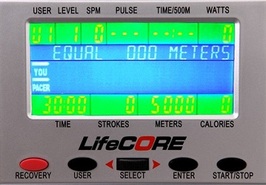 The LifeCore R100 Display The LifeCore R100 Display In Part 1 we looked at how to use the Time, Distance Rowed and Calories data for your benefit and not just to put it down in the 'nice to know' category. In this section we'll cover Stroke Rate, Watts and Heart Rate. They say 'knowledge is power' and it's certainly true when it comes to using the data at your fingertips with training. First up, we often use data and information for the same thing, but they do mean something different. Data relates to numbers that in themselves mean nothing, i.e., raw data - a list of random numbers. Information refers to data that is arranged into meaningful and relational groups so it can be compared and analysed. So that's that sorted :0) So we need to know how to use all the data displayed and convert it into information that is useful. You can see Part 1 here for some creative ways to use what can look like bland data. In this section we'll start with Stroke Rate. The number displayed is the number of strokes per minute (or how many times you're moving up and down the rail). Now you may think that the higher the number, the faster you're rowing, but this doesn't necessarily mean you're working harder. As we looked at in part one, the resistance level is also a factor. For example, if you're rowing at 26 strokes per minute at the highest resistance, you may not be working as hard as rowing at 32 strokes at a middle resistance. A better way to measure your work rate is by checking the Watts figure. This tells you (with each stroke) how much energy you have generated and helps you calculate just how hard you're working. A rower of average fitness could possibly generate around 1.4 watts, or about half the watts a top rower can achieve. This data can be used to formulate workouts that are really challenging - for more on how to calculate a workout based on watts see Tabata Wattage Workouts. And lastly, a really useful piece of information is your heart rate (sometimes referred to as pulse). This tells you what effect your workout is having on your cardio-vascular system. The harder/ faster you row, the more oxygen your body requires, so the faster your heart pumps to deliver it. But this is more than just an interesting fact. One of the more recent developments in workout training is the heart rate program. You can see more about how to calculate your heart training zones here, but briefly, by training with your pulse at a specific rate for a set duration, can help to maximize the benefits from your workout. Research has found at what percentage of your maximum heart you can train at, and for what time, to promote burning fat or promoting fitness. Many rowers are compatible with the popular heart rate monitors and use this information to keep you in your HR zone. It can do this by varying resistance or prompting you to raise your stroke rate. If your machine doesn't have this feature, you can still use a heart rate monitor to display your pulse on a wristwatch and adjust your work rate accordingly. So during your next workout, don't just let your eyes wander over the digits flashing before you, remember all that data is telling you what's happening to your body. Record and use this information to measure your progress and tailor your workouts to push yourself a little further each week. Then you'll see the results and keep coming back to you rower for more :0)
0 Comments
Leave a Reply. |
AuthorRoy Palmer is an athletics coach, teacher of The Alexander Technique and a rowing fanatic. Archives
August 2020
Categories
All
|
 RSS Feed
RSS Feed